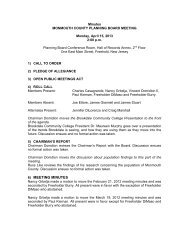NATURAL and CULTURAL FEATURES of MONMOUTH COUNTY
NATURAL and CULTURAL FEATURES of MONMOUTH COUNTY
NATURAL and CULTURAL FEATURES of MONMOUTH COUNTY
Create successful ePaper yourself
Turn your PDF publications into a flip-book with our unique Google optimized e-Paper software.
Poor tidal flushing in warm weather can also lead to anoxic conditions in estuaries with shallow<br />
channels <strong>and</strong> wide mudflats. An odor complaint on Oceanport Creek was investigated in August<br />
<strong>of</strong> 2009 immediately following a fishkill in Branchport Creek. The western portion <strong>of</strong> the creek<br />
had turned septic: black with a foul odor. Anoxic dissolved oxygen <strong>and</strong> elevated temperature<br />
levels were noted. Anoxic conditions were still present the following day, but were showing<br />
significant improvement, following changes in wind <strong>and</strong> rain conditions. The earliest known<br />
report <strong>of</strong> anoxic conditions in this area <strong>of</strong> the Shrewsbury watershed dates back to 1892, when it<br />
was recorded by the Shrewsbury Township Board <strong>of</strong> Health on page 310 <strong>of</strong> the 1892 Report <strong>of</strong><br />
the Board <strong>of</strong> Health <strong>of</strong> the State <strong>of</strong> New Jersey. This report states: "There is a complaint <strong>of</strong> tidewater<br />
backing up on a tributary <strong>of</strong> the South Shrewsbury, known as Little Silver Creek, causing<br />
decay <strong>of</strong> vegetable matter <strong>and</strong> jeopardizing the health <strong>of</strong> neighbors surrounding it. This Board<br />
wishes information as to how it should be opened, <strong>and</strong> what steps are necessary to be taken in the<br />
matter, as all persons owning property adjacent to the creek claim that they have no legal right to<br />
proceed in the matter, as it is the bed <strong>of</strong> the river." (BOHSNJ, 2010) .<br />
Streambeds near malfunctioning septic systems <strong>and</strong> active, unlined l<strong>and</strong>fills will also turn black<br />
from the sulfide produced during the anaerobic decomposition <strong>of</strong> organic material <strong>and</strong> nutrients;<br />
further downstream, these streambeds may support growths <strong>of</strong> “sewage fungus”, a grey floc<br />
produced by the filamentous bacteria Sphaerotilus natans (Curtis <strong>and</strong> Curds, 1971).<br />
The interlaminated s<strong>and</strong>s <strong>and</strong> clays <strong>of</strong> the middle-Miocene Kirkwood aquifer, which is the<br />
largest single outcrop <strong>of</strong> any formation in the County, contains sulfur deposits that give wells a<br />
rotten-egg odor; its black clay base contains bits <strong>of</strong> lignite, a precursor <strong>of</strong> coal (Dahlgren, 1977).<br />
Generally, wells in shallow, water-table aquifers in NJ are acidic, predominantly due to geologic<br />
sulfur deposits (Szabo, 2003).<br />
AIR QUALITY AND PRECIPITATION<br />
NJDEP air monitoring stations are located in Freehold Borough (sulfur dioxide) near the corner<br />
<strong>of</strong> Court <strong>and</strong> West Main St., <strong>and</strong> at Monmouth University in West Long Branch (ozone)<br />
(http://www.state.nj.us/dep/airmon/ ). There are 87 monitoring stations in the state that actively<br />
monitor for carbon monoxide, nitrogen dioxide, ozone, sulfur dioxide, lead, or particulate matter.<br />
The EPA has classified Monmouth County as a non-attainment area for ozone, which is<br />
significant in the summer because it forms in the presence <strong>of</strong> heat <strong>and</strong> sunlight, <strong>and</strong> is associated<br />
with vehicular emissions. About 1 out <strong>of</strong> 5 car trips is work related, <strong>and</strong> about 75 % <strong>of</strong><br />
commuters use ‘single occupancy vehicles’. The USDOT estimates that 2.3 billion gallons <strong>of</strong><br />
fuel are wasted nationally every year while motorists wait in traffic for 3.7 billion hours<br />
(Chebium, 2006). Monmouth County ranked third highest in NJ for the number <strong>of</strong> hours per<br />
year drivers spend in traffic delays, according to a 2001 study by the Foundation <strong>of</strong> the NJ<br />
Alliance for Action <strong>and</strong> the National Center for Transportation <strong>and</strong> Industrial Productivity at the<br />
NJ Institute <strong>of</strong> Technology (Higgs, 2006). From 1994 to 2004, the yearly average is: 326<br />
‘healthy’ days <strong>and</strong> 29 ‘moderately healthy days, with about 3% <strong>of</strong> the year classified as<br />
‘unhealthy <strong>and</strong> ‘unhealthy air for sensitive groups.’<br />
During the winter, winds predominate from the northwest in the Middle Atlantic Bight, due to<br />
the dominance <strong>of</strong> the cyclonic (counterclockwise winds) Icel<strong>and</strong>ic Low; while during the<br />
summer south <strong>and</strong> southwest winds predominate due to the anticyclonic (clockwise winds)<br />
Bermuda High (Cook, 1988; MCPB, 1975; MCPB, 2005). The average wind speed <strong>of</strong> 11 mph is<br />
highest in the spring (ESDRU, 2006). The mean annual temperature for Monmouth County is 53

















